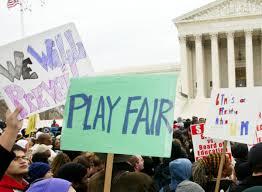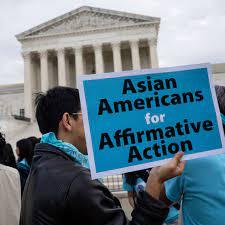The way to stop racial discrimination, Chief Justice Roberts has said, “is to stop discriminating by race.”

The Supreme Court will yet again revisit affirmative action this term, and almost surely outlaw it. Affirmative action in school admissions (and also workplace hiring) is intended to rectify the disadvantage certain minorities (mainly Blacks) have suffered due to past unequal treatment. For all that America has done to fix it, it’s a reality that that past, which included slavery, still causes lingering disadvantage. One glaring example is that schools for Black kids are too often shamefully substandard, handicapping their future prospects. Applied to such students, compensatory affirmative action, in college admissions, makes some sense.
There are two offsetting considerations. One is a tendency to stigmatize the achievements of Blacks as not truly earned but rather the results of preferential treatment. The other is the resentment created in whites; the idea that they are being discriminated against, disadvantaged unfairly, in favor of people not deserving on their merits.

Asian-American students have a particular beef. Tending to excel academically, they claim that if school admissions were strictly merit-based, more of them would get in; but colleges apply tacit quotas to avoid being swamped with Asian-American students.
“Reverse discrimination” is not a completely baseless idea. For every applicant admitted to a college there must be one rejected who would otherwise have made the cut. The “reverse discrimination” of affirmative action has provoked a backlash and the rise of white nationalism, a very bad thing for the country.
Meantime, it cannot be said that affirmative action in college admissions has been a great success at rectifying the kind of racial disadvantage described above. If you simply give extra points to an applicant for being Black, you are going to admit mostly Blacks from middle and upper class families who were thus able to build good resumes, while still excluding the really disadvantaged ones from poor backgrounds. Who, of course, also face financial obstacles to attending college.

So in fact, while colleges and universities have broadly succeeded in achieving racial diversity in student bodies, they have blatantly failed at socio-economic diversity. The overwhelming majority of students are from middle and (especially) upper class families; very few from disadvantaged ones.
It would be no tragedy for that kind of affirmative action to be outlawed by the Court. Though it must be said — why should racial preferences be disallowed, when so many other sorts of preferences remain — notably “legacy” admissions for the children of alumni and donors. Those too are a big factor behind the mentioned socio-economic imbalance in student bodies. And there’s surely less justification for such preferential treatment than there is for the racial sort.
If higher education wants true “diversity” among students, extra points should be given not to race simpliciter but, rather, to students who come out of disadvantaged circumstances and crappy schools and who nevertheless manage, against all odds, to build at least a halfway decent record of achievement. Giving those students a leg up would be the kind of “affirmative” action that will advance true justice and also make a better America.

Surely the Supreme Court’s decision should allow for that. If only the Court were sane.
Advertisement